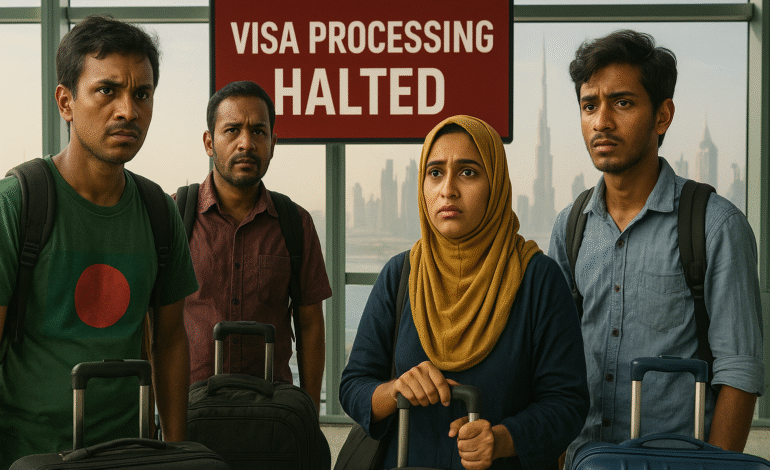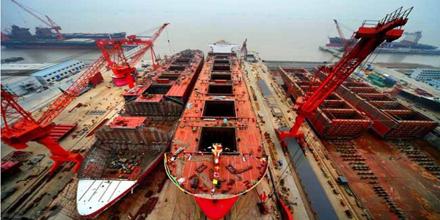UAE Visa Freeze Strikes Bangladesh Labour Market

UAE Visa Freeze and Bangladesh’s Worker Crisis
The UAE visa freeze has sent ripples across Bangladesh’s labour market. Since mid-2024, reports indicate that new work, tourist, and labour visas for Bangladeshis have slowed or stalled. (The Business Standard) For a country whose economy is heavily intertwined with overseas labour, especially in the Gulf, this shift is deeply consequential.
Bangladesh Bank’s data shows that in April-June FY24, the UAE contributed USD 1,329.48 million, about 19.44% of total remittance inflow. (BB) For many families, this money is lifeline. When visa routes close, livelihoods shrink. In this post, we’ll analyze the hit to migrant flows, remittances, worker sentiments, and macro impacts, then look at what can be done.
The Role of UAE in Bangladesh’s Labour Dynamics
Migrant Numbers & Remittance Backbone
Over 1 million Bangladeshis live and work in the UAE, contributing across sectors from construction to domestic services. (Bangladesh Consulate Dubai) In March 2025, remittances from UAE alone were reported at 62,019.7 million BDT (CEIC Data). These funds support education, healthcare, and household consumption back home.
In FY25, Bangladesh achieved record remittances of USD 30.04 billion — a 25.50% increase year on year. (Fair Observer) The UAE’s share is critical here; disruptions can weaken this pillar.
Education, skills, and the promise of better wages drive many to migrate to UAE. The visa freeze cuts off this aspiration.
How the Freeze Hit Migration Flows
Slower Visa Issuance & Blocked Access
Media outlets report that since mid-2024, UAE has quietly slowed visa issuance for Bangladeshis — work, transit, and tourist visas have nearly halted. (The Business Standard) Even delegations have faced delays or rejections. (The Business Standard)
Historically, Bangladesh sent around 100,000 workers yearly to Gulf states. But the number dropped to 47,000 in 2023, likely impacted by these restrictions. (The Daily Star) For many aspiring migrants, their passports await processing for months with no clarity. (The Daily Star)
Indirect Spillovers to Other Gulf Destinations
As the UAE becomes harder to enter, migration pressure may shift to Saudi Arabia, Oman, Qatar, or Malaysia. This could saturate other destinations, push wages down, and increase competition among workers.
Recruitment agencies in Bangladesh are also feeling the strain. With UAE routes clogged, their businesses shrink. Many agents had relied heavily on UAE contracts.
Economic and Social Impacts Back Home
Reduced Remittance Growth
Remittances act as a buffer in Bangladesh’s balance of payments. When labour outflows slow, remittance growth could decelerate. Analysts warn that if bans fully take effect in 2026, inflows may drop sharply. (Remitso)
Already, with slower visas, fewer new workers are entering UAE, meaning less new remittance stream. Long term stays may cushion partially, but the growth trajectory will suffer.
Household Income Shocks
Many rural families depend on migrant income. When that stops, consumption falls. Children’s schooling, health, and debt servicing get squeezed. Women, often dependent on remittances, may experience severe hardship.
Rising Unemployment & Underemployment
With fewer migration options, more job seekers will remain in Bangladesh. Agriculture, construction, and informal sectors may absorb them, but wages will drop. Bangladesh’s domestic labor market is already saturated.
This surge in labor supply could weaken bargaining power and worsen job quality.
Increased Vulnerabilities & Risk of Irregular Migration
Some desperate migrants may resort to smuggling routes or illegal pathways. Without formal visas, they become vulnerable to exploitation, trafficking, or extreme risk. The freeze could inadvertently encourage irregular migration.
Broader Macroeconomic Effects
Exchange Rate & Balance of Payments
Remittances help stabilize Bangladesh’s foreign exchange reserves. A drop in inflows can weaken the taka, raise import costs, and deepen current account deficits. (Trading Economics)
Investment & Credit Stress
Migrant remittances fuel small business investment, housing, and local credit. When that shrinks, credit growth slows and investment drops in rural areas.
Fiscal Pressure
Lower remittances also hurt consumption taxes (VAT, sales), reducing government revenues. At the same time, state support may have to rise for distressed households.
Real Stories & Worker Sentiments
Interviews with hopeful migrants show frustration. Some have waited 13 months for visa processing without progress. (The Daily Star) One migrant described preparing documents, paying fees, and getting no response.
Many feel their ambitions blocked. Some choose alternate migration routes; others give up entirely.
Beyond numbers, this freeze wounds morale. Migration is not just income. It embodies dreams of upliftment, of sending kids to school, of better life.
What Can Bangladesh Do to Mitigate Damage?
Diplomatic Push & Negotiation
The government must take the UAE to the table, demand clarity, and restore visa routes. Bangladesh’s envoy claims bans are rumors, but real slowdowns persist. (Khaleej Times) Clear, negotiated pathways are essential.
Diversify Migration Destinations
Bangladesh should expand labour tie-ups with Malaysia, Singapore, EU, and other growing economies to offset Gulf choke points.
Domestic Job Creation & Skills Upgrade
Invest in manufacturing, digital economy, and infrastructure to absorb labor. Skill training for high-value sectors will reduce reliance on low-wage migration.
Remittance Innovation & Diaspora Engagement
Encourage diaspora to invest in Bangladesh-based enterprises. Create channels for them to fund rural projects or SME ventures at home.
Also, promote digital remittance methods to reduce leakages. (migrantmoney.uncdf.org)
Social Safety Nets for Returnees
Design retraining, microcredit, and reintegration programs for returning/migrants stuck in limbo. Provide them a cushion rather than letting them go destitute.
A Critical Crossroads for Bangladesh’s Labour Market
The UAE visa freeze is more than a migration hiccup. It is a turning point for Bangladesh’s labour economy. The suppression of a key migration route threatens remittances, livelihoods, household security, and macro stability.
But this moment also offers a chance to rethink dependency, diversify options, and build resilience at home. Bangladesh must act fast — diplomatically, economically, and socially — to prevent long-term scars. The fate of millions and the strength of rural economies may hinge on how this disruption is handled.
Would you like me to add infographics or statistical visuals (data charts) to this post? I can suggest layout or content ideas.







